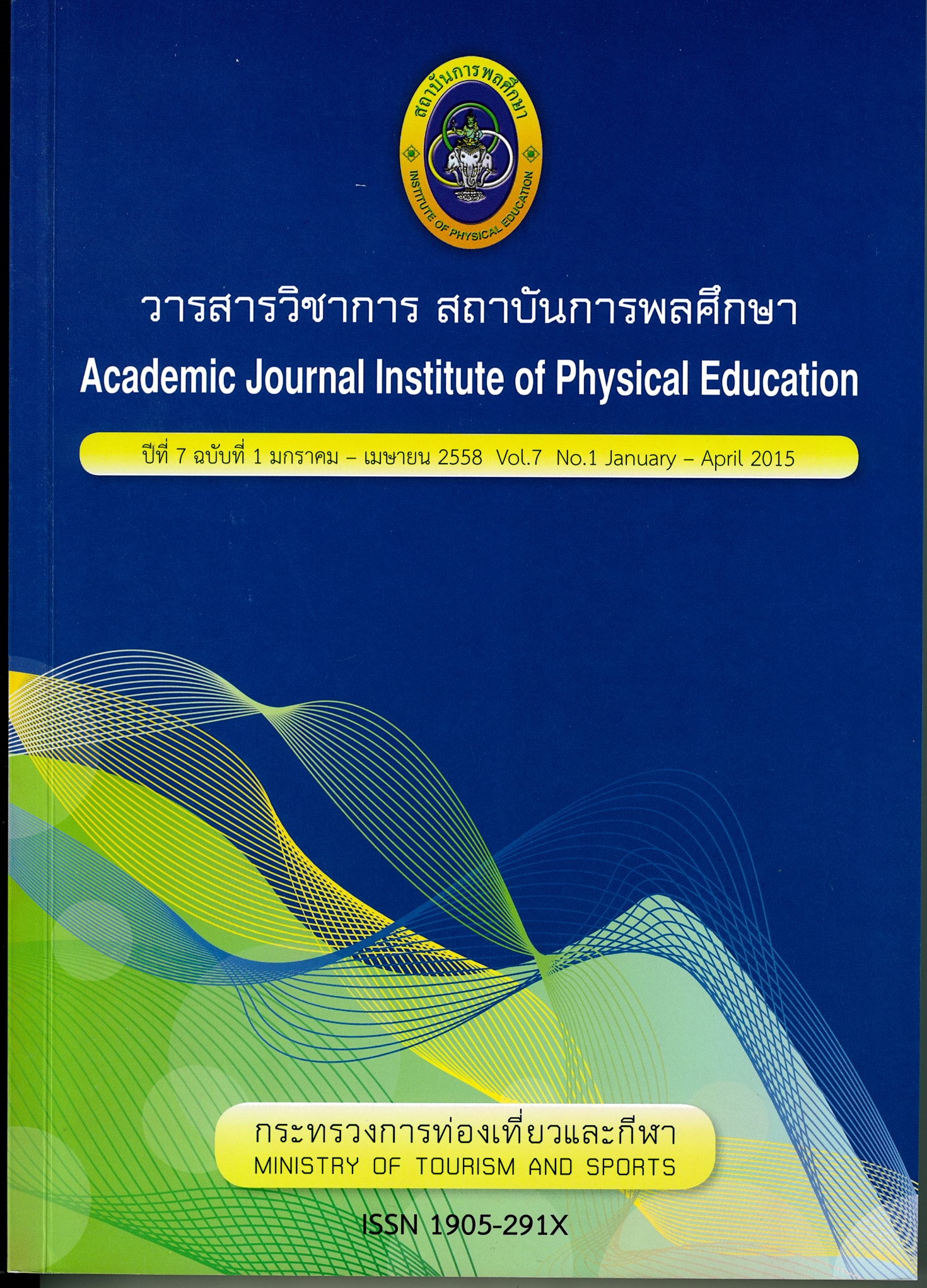Exercise behaviors of pupils in Krabi province
Main Article Content
Abstract
Abstract
The purpose of this study aimed to study exercise behavior and relationship between personal characteristics and exercise behaviors of pupils in Krabi province. The population of this study was pupils from 221 schools in Krabi province, totaling 39,472 people. The sample size of this research was determined using the formula of the Yamane at the tolerance level of + 5%—totaling 494 people. Instruments used in this research were open-ended and five-scales rating questionnaires. The questionnaires were considerate for content validity and reliability utilizing the Cronbach's coefficient alpha with the equivalence of 0.96.
Percentage distribution was applied for determining the general individual data, descriptive statistics for evaluating exercise behavior and Pearson Chi-square for testing relationship between personal characteristics and exercise behavior of the pupils in Krabi province.
Summary of findings
- Most of the population in this study were females, studying primary school in grade 1, their parents were farmers. The pupils though that people need to exercise regularly, and that exercise was very important for health, very easy to practice, needed not much time, contained lot of fun at a high level. Also, they believed that there was no other activity substituting exercise at a moderate level.
- There was no relationship between gender and exercise behavior. As well, there was no relationship between grade levels and exercise behavior in the lights of attitudes and knowledge about exercise. Also, there was no relationship between occupations of the parents and exercise behavior in the lights of attitudes, exercise benefits perceiving and knowledge about exercise and obstacles in exercise.
- There was relationship between grade levels of the pupils and exercise behaviors in the lights of exercise benefits perceiving, how of exercise and obstacles in exercise at a significance level of .05.
- There was relationship between occupations of the parents and exercise behaviors in the lights of knowledge about exercise, and how of exercise at a significance level of .05.
Article Details

This work is licensed under a Creative Commons Attribution-NonCommercial-NoDerivatives 4.0 International License.
The published article is a copyright of the Academic Journal of Thailand National Sports University. The passage appeared in each article in this academic journal is a perspective of each author which is not related to the journal. Each author is required to be responsible for all components of his/her own article. If there are any mistakes, each author must be responsible for those mistakes on his/her own.
References
กัลยา กิจบุญชู. (2546). แนวทางการส่งเสริมการออกกําลังกายในโรงเรียน. นนทบุรี: กองออกกําลังกายเพื่อสุขภาพ กรมอนามัย กระทรวงสาธารณสุข. สืบค้นเมื่อ 18 กรกฎาคม 2556, จาก http://dopah.anamai.moph.go.th/upload/printer/20-12-10-14-19-11-F.pdf.
ชาติชาย พิทักษ์ธนาคม. (2544), จิตวิทยาการเรียนการสอน, กรุงเทพฯ : มหาวิทยาลัยมหาจุฬาลงกรณ์ราชวิทยาลัย.
พรรณทิพย์ ศิริวรรณบุศย์. (2549). ทฤษฎีจิตวิทยาพัฒนาการ. กรุงเทพฯ: แอคทีฟ ฟริ้นท์.
พรรณี ช. เจนจิต. (2554). จิตวิทยาการเรียนการสอน, กรุงเทพฯ: เสริมสิน พรีเพรส ซิสเท็ม.
วิศาล คันธารัตนกุล. (2549). คําแนะนําการออกกําลังกายในเด็ก, วารสารจาร์พา (Foodand Health) 13(88)
วุฒิพงษ์ ปรมัตถากร. (2537). การออกกําลังกาย, กรุงเทพฯ: โอเดียนสโตร์.
สุภาภรณ์ วรอรุณ อาคม โพธิ์สุวรรณ อุมากร ใจยั่งยืน และพรพจน์ บุญญสิทธิ์. (2554). ปัจจัยทํานายการออกกําลังกายของอาสาสมัครสาธารณสุขประจําหมู่บ้าน ตําบลสนามชัย อําเภอเมือง จังหวัด สุพรรณบุรี, วารสารการพยาบาลและการศึกษา ปีที่ 4 ฉบับที่ 1 มกราคม - เมษายน 2554 สืบค้นเมื่อ 4 สิงหาคม 2556, จาก http://www.pi.ac.th/uploads/2011053020110530_5.pdf
สุมาลี สวยสะอาด. (2555), เพศศึกษา. กรุงเทพฯ: พิมพ์ครั้งที่ 1 จุฬาลงกรณ์มหาวิทยาลัย.
สุวิมล ตั้งสัจจพจน์. (2553), นันทนาการและการใช้เวลาว่าง, กรุงเทพฯ: เอดิสันเพรสโพรดักส์.
สํานักงานสถิติแห่งชาติ. (2551). การสํารวจการออกกําลังกายของประชากร, กรุงเทพฯ: ธรรมดาเพรส.
อาธร อุคคติ, วันชัย ธรรมสัจการ และสุเมธ พรหมอินทร์. (2551: 536), ปัจจัยที่มีผลต่อพฤติกรรมสุขภาพ. สงขลานครินทร์เวชสาร. ปีที่ 26 ฉบับที่ 6 พ.ย. - ธ.ค. 2551.
Kim, Y. H. (2004). Korean Adolescents' Exercise Behavior and Its Relationship With Psychological Variables Based on Stages of Change Model. Journal of Adolescent Health 2004; 34:523-530.
Yamane, T. (1967). Statistics and Introductory Analysis. 2nd ed. New York: Harper and Row.


